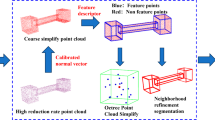Abstract
With the development of modern 3D measurement technologies, it becomes easy to capture dense point cloud datasets. To settle the problem of pruning the redundant points and fast reconstruction, simplification for point cloud is a necessary step during the processing. In this paper, a new method is proposed to simplify point cloud data. The kernel procedure of the method is to evaluate the importance of points based on local entropy of normal angle. After the estimation of normal vectors, the importance evaluation of points is derived based on normal angles and the theory of information entropy. The simplification proceeds and finishes by removing the least important points and updating the normal vectors and importance values progressively until user-specified reduction ratio is reached. To evaluate the accuracy of the simplification results quantitatively, an indicator is determined by calculating the mean entropy of the simplified point cloud. Furthermore, the performance of the proposed approach is illustrated with two sets of validation experiments where other three classical simplification methods are employed for contrast. The results show that the proposed method performs much better than other three methods for point cloud simplification.







Similar content being viewed by others
References
Anil, E. B., Tang, P., Akinci, B., & Huber, D. (2013). Deviation analysis method for the assessment of the quality of the as-is building information models generated from point cloud data. Automation in Construction, 35, 507–516.
Benhabiles, H., Aubreton, O., Barki, H., & Tabia, H. (2013). Fast simplification with sharp feature preserving for 3D point clouds. In 2013 11th international symposium on programming and systems (ISPS), (pp. 47–52).
Guo, L., Bo, W., Chen, Y., Yao, L., Ta, L., Zhou, H., et al. (2010). Vertical deformation and tectonic activity in Tianjin area. Geodesy and Geodynamics, 1(1), 42–47.
Han, H., Han, X., Sun, F., & Huang, C. (2015). Point cloud simplification with preserved edge based on normal vector. Optik-International Journal for Light and Electron Optics, 126(19), 2157–2162.
Hoppe, H., DeRose, T., Duchamp, T., McDonald, J., & Stuetzle, W. (1992). Surface reconstruction from unorganized points (Vol. 26(2), pp. 71–78). New York: ACM.
Hur, S. M., Kim, H. C., & Lee, S. H. (2002). STL file generation with data reduction by the delaunay triangulation method in reverse engineering. The International Journal of Advanced Manufacturing Technology, 19(9), 669–678.
Kalaiah, A., & Varshney, A. (2003). Modeling and rendering of points with local geometry. IEEE Transactions on Visualization and Computer Graphics, 9(1), 30–42.
Linsen L (2001). Point cloud representation. Technical Report, Faculty of Informatics, University of Karlsruhe, Germany.
Luebke, D. P. (2001). A developer’s survey of polygonal simplification algorithms. IEEE Computer Graphics and Applications, 21(3), 24–35.
Moenning, C., & Dodgson, N. A. (2003). A new point cloud simplification algorithm. In Proceedings of international conference on visualization, imaging and image processing (pp. 1027–1033).
Pauly, M., Gross, M., & Kobbelt, L. P. (2002). Efficient simplification of point-sampled surfaces. In Proceedings of the conference on visualization’02 (pp. 163–170). IEEE Computer Society.
Shi, B. Q., Liang, J., & Liu, Q. (2011). Adaptive simplification of point cloud using k-means clustering. Computer-Aided Design, 43(8), 910–922.
Song, H., & Feng, H. Y. (2009). A progressive point cloud simplification algorithm with preserved sharp edge data. The International Journal of Advanced Manufacturing Technology, 45(5–6), 583–592.
Xuan, W., Hua, X., Zou, J., & He, X. (2016). Determining the deformation monitorable indicator of point cloud using error ellipsoid. Journal of the Indian Society of Remote Sensing. https://doi.org/10.1007/s12524-016-0580-7.
Yang, R., Hu, Y., Lü, M., Hua, X., & Wu, H. (2015). Initial study on information quantity of point cloud. Journal of the Indian Society of Remote Sensing, 43(2), 243–258.
Yastikli, N. (2007). Documentation of cultural heritage using digital photogrammetry and laser scanning. Journal of Cultural Heritage, 8(4), 423–427.
Zhao, X., Zhang, C., Xu, L., Yang, B., & Feng, Z. (2013). IGA-based point cloud fitting using B-spline surfaces for reverse engineering. Information Sciences, 245, 276–289.
Zheng, D. (2006). The data reduction of point cloud and analysis of reduction effect. Engineering of Surveying and Mapping, 15(4), 27–30.
Acknowledgements
This work is supported by the National Natural Science Foundation of China (Grant No. 41674005, 41501502), the CRSRI Open Research Program (CKWV2015230/KY), the Key Laboratory for Digital Land and Resources of Jiangxi Province, East China University of Technology (DLLJ201601), Jiangxi Natural Science Foundation of China (20171BAB203032), and the Open Foundation of Postdoctors Innovation and Practice Base of Wuhan Geomatics Institute (Grant No. WGF 2016002).
Author information
Authors and Affiliations
Corresponding author
Electronic supplementary material
Below is the link to the electronic supplementary material.
About this article
Cite this article
Xuan, W., Hua, X., Chen, X. et al. A New Progressive Simplification Method for Point Cloud Using Local Entropy of Normal Angle. J Indian Soc Remote Sens 46, 581–589 (2018). https://doi.org/10.1007/s12524-017-0730-6
Received:
Accepted:
Published:
Issue Date:
DOI: https://doi.org/10.1007/s12524-017-0730-6




